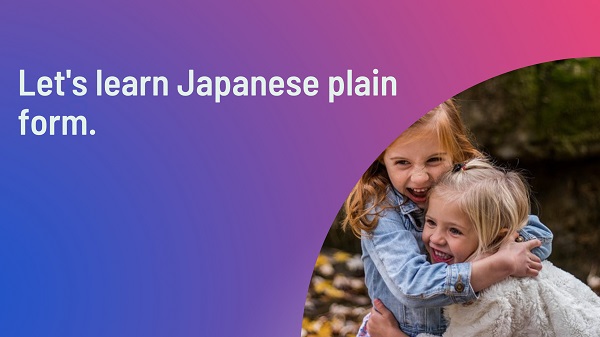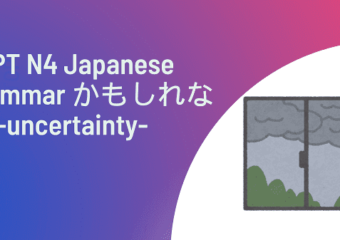When you talk with your friends, you would want to be casual, right?
There are two types of sentences, polite form and plain form.
We usually use plain form to talk to friends, so in this article, I will teach you what plain form is.
*Are you looking for a place to practice Japanese?
Youtonihongo is for you.
You may receive one free 30-minute trial lesson.
What is plain form?
Plain form includes “dictionary form”, “te iru form”, “te ita form”, “ta form”, “nai form”, and “nakkata form”.
Please read this article to know the verb groups and dictionary form.
Japanese verb conjugation rule with chart
In plain form, when we ask something, we don’t use ~か.
Instead, we use rising intonation on the final word.
Let’s listen. I say ごはんたべる?, which means will you eat?
Then, I say うん、たべる, which means yes, I will.
I say これおいしい? and おいしい, which mean is it good? Yes, it is.
ナ adjectives and nouns are a little bit tricky.
We put だ at the end of sentences in declarative sentences, but we don’t put だ in question sentences.
Please listen to following voices.
First, I say なっとうすき? Response; うん、すき, which means do you like natto? Yes I do.
Next I say ぼくは えいがが すきだ, which means I like movies.
ている
We use ている to say that an action is being performed.
Polite form is ています.
For instance, かれは いま しゅくだいを しています。
It means he’s doing his homework.
The plain form is that かれは いま しゅくだいを している.
In addition, the Past continuous form is like かれは しゅくだいを していた。
If you don’t know what te form is, please read this article.
Learning Japanese conjugation te form
Let’s listen to this conversation.
I say いまなにしている? and しゅくだいしている。
That means what are you doing? and I’m doing my homework.
タ form
We usually use タ form to explain a past experience.
The verb conjugation work in the same pattern for both the タ form and the テ form.
Please read this article for more detail.
Japanese verbs conjugation-past tense
Verb conjugation
Group 1 is a little bit hard to remember.
These verb changes form like this chart.
Group 2 is easier than group 1.
Just take る and put た.
たべる→たべ→たべた.
Group 3 is an irregular verb.
する→した and くる→きた.
| Group 1 | |||
| います ちます ります | った | かいます たちます つくります | かった たった つくった |
| にます びます みます | んだ | しにます あそびます よみます | しんだ あそんだ よんだ |
| きます | いた | かきます | かいた |
| ぎます | いだ | およぎます | およいだ |
| します | した | かします | かした |
| × | × | いきます | いって |
| Group 2 | |||
| Take ru and add ta | みる(miru) | み | みた(mita) |
| Group 3 | |||
| する→した くる→きた |
Let’s listen to one example.
I say ごはんたべた? and うん、たべた.
That means did you eat? Yes, I did.
イ adjective
There are two types of adjectives, イ adjective and ナ adjective.
If you don’t know the difference, please read this article.
Learning Japanese grammar-adjectives conjugation
Conjugation
take い and put かった.
おおきい→おおき→おおきかった。
Let’s listen to one example.
I say あのえいがよかった? and うん、よかった.
That means was the movie good? Yes, it was.
ナ adjective and noun
Conjugation
Just put だった with ナ adjective or noun.
きれいです→きれいだった。
すきです→すきだった。
せんせいです→せんせいだった。
This river was clean.
He was a teacher.
ない、なかった
ない (declarative sentences) and なかった (past tense) are used for negative sentences.
Please read this article for more information.
learning negative sentences in japanese
Verb conjugation
Group 1…u changes a sound and put ない (or なかった).
かく(kaku)→かかない(kakaない)
Group 2… take る and put ない.
たべる→たべ→たべない.
Group 3… する→しない、くる→こない.
When someone asks “なっとうたべない?”, that means do you want to eat natto?
Then if you don’t want to eat natto, you would say いや、たべない.
If you want to eat it, you would say うん、たべる.
Please read this article too.
Japanese grammar masenka vs mashou
イ adjective
Take い and add くない (くなかった).
おおきい→おおき→おおきくない.
Please keep it mind that if I say “かわいくない?”, it means it’s cute, right?
The question isn’t negative.
noun and ナ adjective
Put じゃない (じゃなかった) with ナ adjective or noun.
きれいです→きれいじゃない.
せんせいです→せんせいじゃない.
Please keep it mind that if I say “きれいじゃない?”, it means it’s beautiful, right?
The question isn’t negative.
Also, when you found someone who looks your teacher, you would ask your friend that “あのひと、せんせいじゃない?”
That means that man is our teacher, right?
Exercise
Let’s change to plain form.
① たべます→
② かきます→
③ きました→
④ ききました→
⑤ せんせいでした→
⑥ すきじゃありません→
⑦ いそがしいです→
⑧ しずかです→
⑨ たかくありません→
⑩ よみません→
Answer
① たべます→たべる
② かきます→かく
③ きました→きた
④ ききました→きいた
⑤ せんせいでした→せんせいだった
⑥ すきじゃありません→すきじゃない
⑦ いそがしいです→いそがしい
⑧ しずかです→しずかだ
⑨ たかくありません→たかくない
⑩ よみません→よまない
If you have questions, please comment below.
If you’d like to learn more Japanese, please feel free to contact me.
I teach Japanese in-person or online.
You can also learn Japanese on my Instagram page.

The free trial class online
We offer online classes and in person classes



